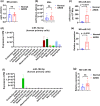Identification of circulating microvesicle-encapsulated miR-223 as a potential novel biomarker for ARDS
- PMID: 36353917
- PMCID: PMC9647359
- DOI: 10.14814/phy2.15494
Identification of circulating microvesicle-encapsulated miR-223 as a potential novel biomarker for ARDS
Abstract
Acute respiratory distress syndrome (ARDS) is a lethal disease with severe forms conferring a mortality rate approaching 40%. The initial phase of ARDS results in acute lung injury (ALI) characterized by a severe inflammatory response and exudative alveolar flooding due to pulmonary capillary leak. Timely therapies to reduce ARDS mortality are limited by the lack of laboratory-guided diagnostic biomarkers for ARDS. The purpose of this study was to evaluate the prognostic role of circulating microvesicles (MVs)-containing miR-223 (MV-miR-223) if indicate more severe lung injury and worse outcomes in ARDS patients. Human plasma samples from one hundred ARDS patients enrolled in Albuterol to Treat Acute Lung Injury (ALTA) trial were compared to a control group of twenty normal human plasma specimens. The amount of MV-miR-223 was measured using absolute real-time polymerase chain reaction (PCR) with a standard curve. Mann-Whitney-Wilcoxon, Spearman correlation, Chi-squared tests, and Kaplan-Meier curves were computed to assess different variables and survival. Plasma levels of MV-miR-223 were significantly higher in ARDS patients compared to normal control subjects. Upon receiver operator characteristic (ROC) analysis of MV-miR-223 in relation to 30-day mortality, MV-miR-223 had an area under the curve (AUC) of 0.7021 with an optimal cut-off value of 2.413 pg/ml. Patients with high MV-miR-223 had higher 30-day mortality than subjects with low MV-miR-223 levels. MV-miR-223 was negatively correlated with ICU-free days, ventilator-free days, and organ failure-free days. Patients with high MV-miR-223 levels had higher 30 and 90-day mortality. MV-miR-223 was associated with 28-day clinical outcomes of ALTA trial including ICU-free days, ventilator-free days, and organ failure-free days. Thus, circulating MV-miR-223 may be a potential biomarker in prognosticating patient-centered outcomes and predicting mortality in ARDS.
Keywords: acute lung injury; extracellular vesicles; inflammation; microRNA; neutrophil; sepsis.
© 2022 The Authors. Physiological Reports published by Wiley Periodicals LLC on behalf of The Physiological Society and the American Physiological Society.
Conflict of interest statement
The authors declare that they have no competing interests. The funders had no role in the design of the study; in the collection, analyses, or interpretation of data; in the writing of the manuscript, or in the decision to publish the results.
Figures





References
-
- Bauernfeind, F. , Rieger, A. , Schildberg, F. A. , Knolle, P. A. , Schmid‐Burgk, J. L. , & Hornung, V. (2012). NLRP3 inflammasome activity is negatively controlled by miR‐223. Journal of Immunology, 189(8), 4175–4181. - PubMed
-
- Brook, A. C. , Jenkins, R. H. , Clayton, A. , Kift‐Morgan, A. , Raby, A. C. , Shephard, A. P. , Mariotti, B. , Cuff, S. M. , Bazzoni, F. , Bowen, T. , Fraser, D. J. , & Eberl, M. (2019). Neutrophil‐derived miR‐223 as local biomarker of bacterial peritonitis. Scientific Reports, 9(1), 10136. - PMC - PubMed
-
- Chen, C. , Ridzon, D. A. , Broomer, A. J. , Zhou, Z. , Lee, D. H. , Nguyen, J. T. , Barbisin, M. , Xu, N. L. , Mahuvakar, V. R. , Andersen, M. R. , Lao, K. Q. , Livak, K. J. , & Guegler, K. J. (2005). Real‐time quantification of microRNAs by stem‐loop RT‐PCR. Nucleic Acids Research, 33(20), e179. - PMC - PubMed
-
- Chevillet, J. R. , Kang, Q. , Ruf, I. K. , Briggs, H. A. , Vojtech, L. N. , Hughes, S. M. , Cheng, H. H. , Arroyo, J. D. , Meredith, E. K. , Gallichotte, E. N. , Pogosova‐Agadjanyan, E. L. , Morrissey, C. , Stirewalt, D. L. , Hladik, F. , Yu, E. Y. , Higano, C. S. , & Tewari, M. (2014). Quantitative and stoichiometric analysis of the microRNA content of exosomes. Proceedings of the National Academy of Sciences of the United States of America, 111(41), 14888–14893. - PMC - PubMed
Publication types
MeSH terms
Substances
Grants and funding
LinkOut - more resources
Full Text Sources

